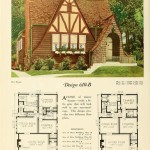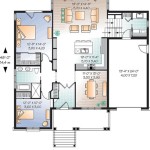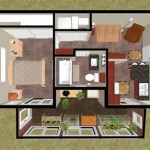A flower bed plan for the front of the house is a carefully designed layout that guides the placement and arrangement of flowers, plants, and other elements within a designated area in front of a house. Its primary purpose is to enhance the aesthetic appeal of the property, create a welcoming atmosphere, and add curb appeal to the home. An example of a well-executed flower bed plan in front of a house would be a symmetrical design featuring colorful annuals and perennials, bordered by a low-growing hedge or edging material.
Creating an effective flower bed plan for the front of a house involves careful consideration of various factors, including the size and shape of the area, the desired style and color scheme, and the specific plant species that will thrive in the given location. With proper planning and execution, a well-designed flower bed can transform the front of a house into a vibrant and inviting space that showcases the homeowner’s taste and personality.
When planning a flower bed for the front of your house, keep these key points in mind:
- Choose a focal point
- Consider the size and shape
- Select a color scheme
- Plan for succession of bloom
- Include a variety of textures
- Add height and drama
- Provide proper drainage
- Consider the climate
- Use edging to define the space
- Maintain regularly
By following these guidelines, you can create a beautiful and inviting flower bed that will enhance the curb appeal of your home.
Choose a focal point
Every flower bed needs a focal point, or a central element that draws the eye and creates visual interest. This could be a single specimen plant, a group of plants, or even a piece of garden art. When choosing a focal point, consider the size and shape of your flower bed, as well as the overall style you are trying to achieve.
For a small flower bed, a single specimen plant can be a good choice. Look for a plant with interesting foliage, flowers, or both. If your flower bed is larger, you can create a focal point by grouping several plants together. Choose plants with different heights, textures, and colors to create a dynamic and visually appealing display.
If you want to add a touch of whimsy to your flower bed, consider using a piece of garden art as a focal point. This could be a statue, a birdbath, or even a wind chime. Just be sure to choose something that is in keeping with the overall style of your flower bed.
Once you have chosen a focal point, arrange the rest of the plants in your flower bed around it. Be sure to leave enough space between the plants so that they have room to grow and thrive. You can also use other elements, such as rocks, mulch, or edging, to add interest and definition to your flower bed.
Consider the size and shape
The size and shape of your flower bed will determine the types of plants you can grow and the overall look of your design. Here are a few things to keep in mind:
- Small flower beds: Small flower beds are ideal for creating a focal point or adding a touch of color to a small space. When choosing plants for a small flower bed, it is important to select compact varieties that will not overcrowd the space. You can also use vertical elements, such as trellises or hanging baskets, to add height and interest to a small flower bed.
- Large flower beds: Large flower beds give you more room to experiment with different plant combinations and create a more dramatic display. When planning a large flower bed, it is important to consider the overall shape of the bed and how it will be viewed from different angles. You can also use different types of edging to create a more formal or informal look.
- Odd-shaped flower beds: Odd-shaped flower beds can be a challenge to design, but they can also be very interesting and unique. When planning an odd-shaped flower bed, it is important to take into account the curves and angles of the bed. You can use plants with different heights and textures to create a sense of balance and harmony.
- Raised flower beds: Raised flower beds are a good option for areas with poor drainage or if you want to create a more formal look. Raised flower beds can be made from a variety of materials, such as wood, brick, or stone. When planning a raised flower bed, be sure to choose a material that is durable and will complement the style of your home.
Once you have considered the size and shape of your flower bed, you can start to choose the plants that you want to grow. Be sure to select plants that are well-suited to the climate in your area and that will thrive in the conditions in your flower bed.
Select a color scheme
The color scheme you choose for your flower bed will have a big impact on the overall look and feel of your front yard. There are a few things to keep in mind when choosing a color scheme:
- The style of your home: The color scheme of your flower bed should complement the style of your home. For example, a traditional home might look best with a formal color scheme featuring classic colors like white, blue, and red. A modern home might look best with a more contemporary color scheme featuring bold colors like orange, yellow, and purple.
- The size of your flower bed: The size of your flower bed will also affect the color scheme you choose. A small flower bed might look best with a simple color scheme featuring a few well-chosen colors. A large flower bed can handle a more complex color scheme with a wider variety of colors.
- The amount of sunlight your flower bed receives: The amount of sunlight your flower bed receives will also affect the color scheme you choose. Plants that need full sun will generally have brighter, more vibrant colors than plants that need shade. If your flower bed is in a shady area, you might want to choose a color scheme with cooler colors, such as blues and greens.
Once you have considered these factors, you can start to choose the colors for your flower bed. Here are a few tips:
- Use a color wheel to help you choose colors that complement each other.
- Start with a few basic colors and then add in accent colors to create interest.
- Don’t be afraid to experiment with different color combinations until you find one that you love.
Here are a few popular color schemes for flower beds:
- Monochromatic: A monochromatic color scheme uses different shades of the same color. This can create a very elegant and sophisticated look.
- Complementary: A complementary color scheme uses colors that are opposite each other on the color wheel. This can create a very vibrant and eye-catching look.
- Analogous: An analogous color scheme uses colors that are adjacent to each other on the color wheel. This can create a very harmonious and peaceful look.
- Triadic: A triadic color scheme uses three colors that are evenly spaced around the color wheel. This can create a very dynamic and energetic look.
Plan for succession of bloom
One of the most important things to consider when planning a flower bed is the succession of bloom. This refers to the sequence in which your plants will flower, so that you have a continuous display of color throughout the growing season. To achieve this, you need to choose plants that bloom at different times of the year.
Here are a few tips for planning for succession of bloom:
- Start with a base of evergreen plants. These plants will provide a backdrop of color and interest all year round, even when your other plants are not in bloom.
- Choose plants that bloom in different seasons. This will ensure that you have something blooming in your flower bed from early spring to late fall.
- Consider the length of the blooming period for each plant. Some plants bloom for only a few weeks, while others bloom for several months. By choosing plants with different blooming periods, you can create a flower bed that is constantly changing and evolving.
- Don’t forget about foliage. Even when your plants are not in bloom, their foliage can still add interest and texture to your flower bed. Choose plants with attractive foliage that will complement the colors of your flowers.
By following these tips, you can create a flower bed that is beautiful and interesting all year round.
Here are a few examples of plants that bloom at different times of the year:
- Spring: tulips, daffodils, hyacinths, crocuses, pansies, violas
- Summer: roses, lilies, daylilies, zinnias, petunias, impatiens
- Fall: asters, chrysanthemums, sunflowers, marigolds, salvia
- Winter: hellebores, pansies, violas, rosemary, boxwood
Include a variety of textures
In addition to color and bloom time, you should also consider the texture of the plants in your flower bed. Texture refers to the surface quality of a plant’s leaves and stems. Plants with different textures can add interest and depth to your flower bed.
- Smooth: Plants with smooth leaves, such as hostas and ferns, can create a sense of calm and serenity in your flower bed. They are also a good choice for shady areas.
- Rough: Plants with rough leaves, such as lamb’s ear and rosemary, can add a touch of drama to your flower bed. They are also a good choice for sunny areas.
- Fuzzy: Plants with fuzzy leaves, such as lamb’s ear and lavender, can add a touch of softness to your flower bed. They are also a good choice for attracting butterflies and other pollinators.
- Spiky: Plants with spiky leaves, such as yucca and agave, can add a touch of drama and interest to your flower bed. They are also a good choice for areas with poor drainage.
By including a variety of textures in your flower bed, you can create a more visually interesting and dynamic display. You can also use texture to create contrast and balance in your flower bed.
Add height and drama
One way to add height and drama to your flower bed is to use plants with different heights. Taller plants can be used to create a focal point or to add a sense of grandeur to your flower bed. Shorter plants can be used to fill in the gaps between taller plants and to create a more balanced look.
Here are a few tips for adding height and drama to your flower bed with plants:
- Use a variety of plant heights. Taller plants can be used to create a focal point or to add a sense of grandeur to your flower bed. Shorter plants can be used to fill in the gaps between taller plants and to create a more balanced look.
- Plant taller plants in the back of the flower bed. This will create a sense of depth and interest. You can also use taller plants to create a backdrop for shorter plants.
- Use shorter plants in the front of the flower bed. This will help to frame the flower bed and to create a more cohesive look.
- Use plants with different shapes and textures to add interest. For example, you could use a tall, spiky plant next to a shorter, rounded plant.
By following these tips, you can add height and drama to your flower bed and create a more visually interesting and dynamic display.
Here are a few examples of plants that can be used to add height and drama to your flower bed:
- Tall plants: delphiniums, hollyhocks, sunflowers, lilies
- Short plants: pansies, violas, petunias, impatiens
- Plants with different shapes and textures: yucca, agave, lamb’s ear, rosemary
Provide proper drainage
Proper drainage is essential for the health of your plants. Without proper drainage, water can collect around the roots of your plants and cause them to rot. This can lead to a variety of problems, including stunted growth, yellowing leaves, and wilting.
There are a few things you can do to ensure that your flower bed has proper drainage. First, choose a planting site that has well-drained soil. Sandy or loamy soil is ideal, as it allows water to drain easily. If your soil is not well-drained, you can improve it by adding organic matter, such as compost or peat moss. You can also create raised beds to improve drainage.
In addition to choosing a well-drained planting site, you should also make sure that your flower bed is properly graded. The soil should slope away from your house so that water can drain away from the foundation. You should also avoid planting your flower bed in a low-lying area where water is likely to collect.
If you are planting in containers, make sure that the containers have drainage holes. You should also place the containers on a raised surface so that water can drain away from the bottom of the containers.
By following these tips, you can ensure that your flower bed has proper drainage and that your plants are healthy and happy.
Consider the climate
When planning your flower bed, it is important to consider the climate in your area. This will help you choose plants that are well-suited to your climate and that will thrive in your flower bed.
- Hardiness zone: The hardiness zone is a measure of the average minimum temperature in your area. It is important to choose plants that are hardy to your hardiness zone. Plants that are not hardy to your hardiness zone may not survive the winter.
- Amount of sunlight: The amount of sunlight your flower bed receives will also affect the types of plants you can grow. Some plants need full sun, while others can tolerate partial shade or even full shade. Be sure to choose plants that are suited to the amount of sunlight your flower bed receives.
- Amount of rainfall: The amount of rainfall your area receives will also affect the types of plants you can grow. Some plants are drought-tolerant and can survive with little water, while others need more water to thrive. Be sure to choose plants that are suited to the amount of rainfall your area receives.
- Wind: If your area is windy, you will need to choose plants that can withstand strong winds. Some plants are more wind-resistant than others. Be sure to choose plants that are suited to the wind conditions in your area.
By considering the climate in your area, you can choose plants that are well-suited to your climate and that will thrive in your flower bed.
Use edging to define the space
Edging is a great way to define the space of your flower bed and to create a more finished look. It can also help to keep your plants in place and to prevent weeds from invading your flower bed.
- Bricks: Bricks are a classic edging material that can add a touch of elegance to your flower bed. They are also very durable and easy to install.
- Stones: Stones are another popular edging material that can give your flower bed a more natural look. They are also very durable and easy to install.
- Concrete: Concrete is a more permanent edging material that can be used to create a variety of shapes and designs. It is also very durable and easy to maintain.
- Wood: Wood is a versatile edging material that can be used to create a variety of looks. It is also relatively inexpensive and easy to install.
When choosing an edging material, be sure to consider the style of your home and the overall look you want to achieve for your flower bed. You should also consider the cost and ease of installation of the material.
Maintain regularly
Regular maintenance is essential to keep your flower bed looking its best and to ensure that your plants are healthy and thriving.
- Water regularly: Water your flower bed regularly, especially during hot and dry weather. The amount of water you need to give your flower bed will vary depending on the type of plants you have and the climate in your area. As a general rule, you should water your flower bed deeply and infrequently, rather than shallowly and frequently.
- Fertilize regularly: Fertilize your flower bed regularly to provide your plants with the nutrients they need to grow and bloom. The type of fertilizer you use will depend on the type of plants you have. Be sure to follow the instructions on the fertilizer package.
- Weed regularly: Weeds can compete with your plants for water, nutrients, and sunlight. Be sure to weed your flower bed regularly to prevent weeds from taking over.
- Prune regularly: Pruning is essential to keep your plants healthy and looking their best. Prune your plants to remove dead or diseased leaves and stems, to encourage new growth, and to shape your plants.
By following these tips, you can keep your flower bed looking its best and ensure that your plants are healthy and thriving.










Related Posts








